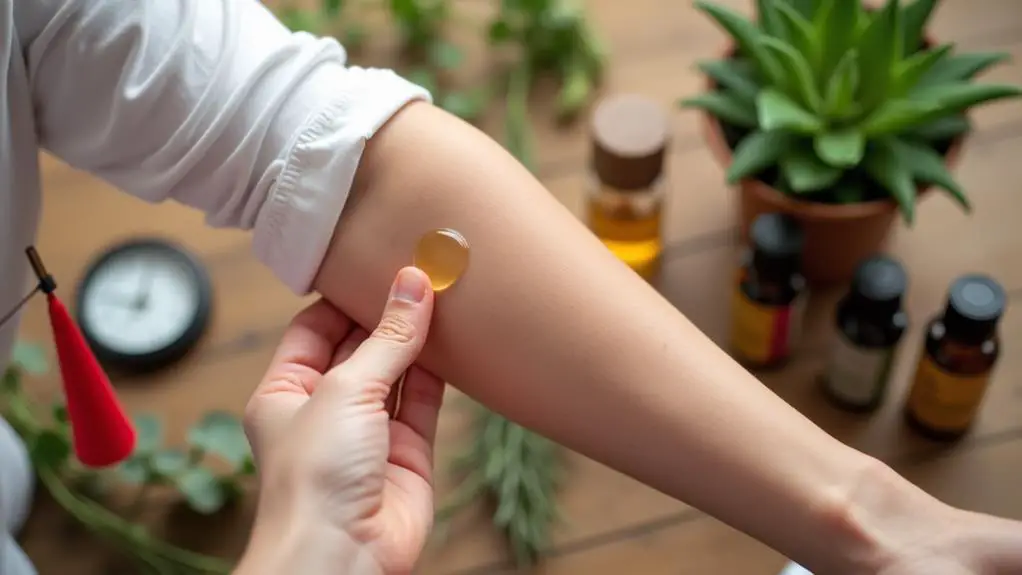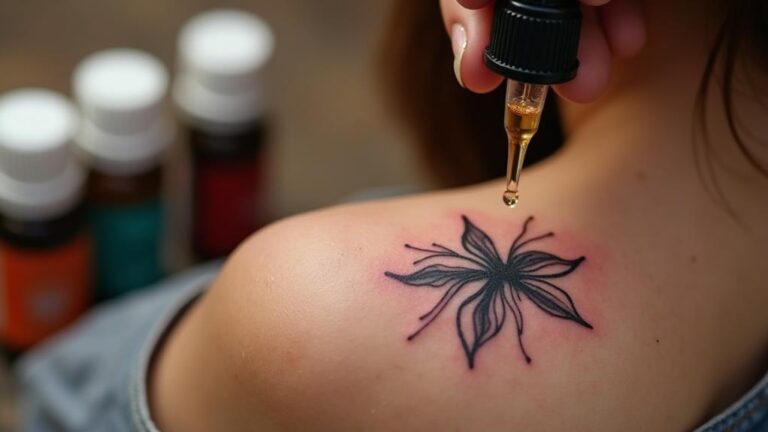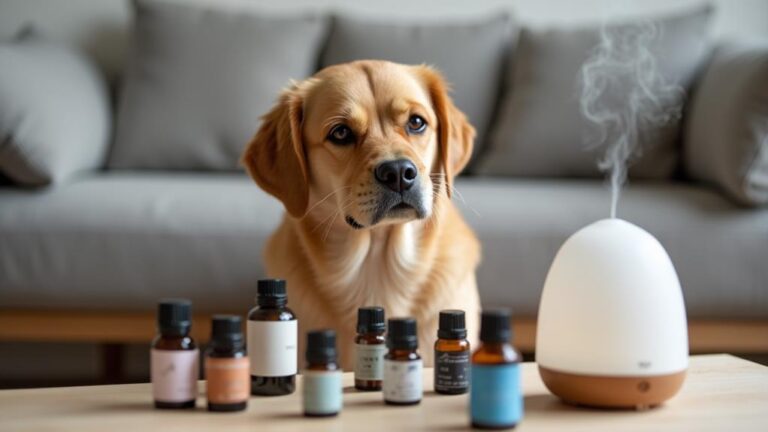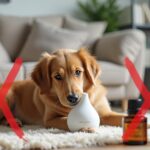You're about to start using essential oils, but you're not sure if you're allergic to any of them. That's a good concern – essential oils can be potent and cause skin irritation. Before you start applying them, it's vital to test for allergies. The process is relatively simple: preparing your skin, applying a small amount of the oil, and monitoring for reactions. However, there's more to it than just slapping on some oil. You need to know the right way to test, common allergens to watch out for, and what to do if you have sensitive skin.
Key Takeaways
- Perform a patch test to check for essential oil allergies, as some oils can cause skin irritation or allergic reactions.
- Prepare the skin by avoiding moisturizers and lotions 24 hours before the test and selecting test areas with no skin irritations.
- Apply a few drops of the essential oil to a patch and secure it to the skin with adhesive to test for reactions.
- Observe the test area for 24-48 hours for signs of a positive reaction, such as redness, itching, or swelling.
- Remove the patch immediately and wash the area with soap and water if a positive reaction is observed.
Understanding Essential Oil Allergies
When using essential oils, it's vital to think about the possibility of an allergic reaction. Essential oil intolerance and allergies can be serious concerns, so it's crucial to separate fact from fiction.
There are several allergy myths surrounding essential oils that need to be debunked. One common misconception is that essential oils are completely safe because they're natural. However, just like any other substance, essential oils can cause adverse reactions in some individuals.
Essential oil intolerance is a real concern, and it's different from a full-blown allergy. Intolerance occurs when your body has difficulty processing the oil, leading to symptoms like headaches, nausea, or skin irritation.
On the other hand, an allergy involves an immune system reaction, which can be more severe. To minimize the risk of an allergic reaction, it's essential to understand your body's unique response to essential oils.
Preparing for the Patch Test
Before proceeding with a patch test, it's essential that you're adequately prepared to minimize potential risks and guarantee accurate results.
Start by establishing good hygiene practices, such as washing your hands thoroughly with soap and water, and dry them completely before handling any essential oils or test materials.
Proper skin preparation is also vital to guarantee the patch test is effective.
Avoid applying any moisturizers, lotions, or oils to the test area for at least 24 hours prior to the test. This will help prevent any interference with the essential oils being tested.
Additionally, choose a test area that's free from any skin irritations or conditions, such as eczema, acne, or sunburn.
Guarantee the test area is clean and dry before applying the test patches.
Remove any hair from the test area, as it can interfere with the patch test results.
By following these simple steps, you'll be well-prepared for the patch test, and you can rest assured that the results will be accurate and reliable.
This preparation will help you identify any potential allergies and take the necessary steps to guarantee your safety when using essential oils.
Essential Oil Patch Testing
To start the patch test, you'll need to choose discreet test locations on your skin that are easy to monitor, such as behind your ear or on your wrist.
This will allow you to assess any reactions without causing discomfort or affecting your daily activities. Next, you'll prepare the patches by applying a small amount of the essential oil to a band-aid or a piece of gauze, which you'll then secure to the test location.
Choosing Test Locations
You'll typically start by selecting multiple test locations for your essential oil patch testing, as this increases the likelihood of identifying potential allergies and reduces the risk of false negatives.
When choosing these locations, consider the concept of skin mapping, which involves dividing your body into distinct zones to identify potential areas of sensitivity.
Divide your body into zones such as the arms, legs, torso, and back, and select test locations that are easily accessible and visible.
Select locations with thin skin, as these areas are more prone to irritation. Typically, the inner forearm, behind the ear, and the crook of the elbow are good test locations.
Avoid areas with broken or irritated skin, as this can skew test results. Also, consider avoiding areas with a high concentration of sebaceous glands, such as the face and neck, as these areas may be more prone to false positives.
By carefully selecting your test locations, you can increase the accuracy of your patch test results and guarantee a safe and reliable allergy testing experience.
Select 2-3 locations for each essential oil you plan to test.
Preparing the Patches
When preparing patches for essential oil patch testing, it's crucial that you create a controlled environment to accurately assess potential skin reactions.
Start by gathering small pieces of gauze or cotton pads, as well as a patch adhesive to secure them in place. Take protective measures to minimize the risk of contamination and exposure to the essential oils.
Wash your hands thoroughly before handling the patches, and work in a well-ventilated area.
To prepare the patches, apply a few drops of the essential oil to the gauze or cotton pad.
Make sure to use a consistent amount for each test to guarantee accurate results.
Cut the patches into identical sizes to prevent any variations in skin contact.
Use the patch adhesive to secure the patches to your skin, pressing firmly to confirm they stick properly.
Once the patches are prepared, you're ready to move on to the testing phase, where you'll apply the patches to your chosen test locations and monitor for any adverse reactions.
Reading the Patch Test Results
As you evaluate your patch test results, you're looking for signs of a positive reaction, which may indicate an allergy or sensitivity to a particular essential oil.
A positive reaction can manifest in various ways, including redness, itching, swelling, or blistering at the test site.
Conversely, a negative reaction is typically characterized by no visible changes or mild, transient reactions that resolve on their own.
Positive Reaction Signs
Clarity is key when reading the results of your essential oil patch test. As you inspect the tested area, look for any visible signs of a skin reaction. Identifying these signs is vital in determining whether you have a sensitivity or allergy to a particular essential oil.
This knowledge will help you employ effective allergy prevention methods and guarantee safe usage.
A positive reaction can manifest in various ways. Be on the lookout for:
- Redness or inflammation, which can range from mild pinkness to intense redness
- Itching or burning sensations, which can be uncomfortable and even painful
- Blisters, rashes, or welts, which can be painful and unsightly
- Swelling or thickening of the skin, which can be a sign of a more severe reaction
If you notice any of these skin reaction signs, it's vital to take action. Remove the patch immediately and wash the area with soap and water. This will help prevent further irritation and minimize the risk of a more severe reaction.
Negative Reaction Indicators
Your skin has provided the initial feedback from the patch test, and now it's time to analyze the results.
When it comes to negative reaction indicators, you're basically looking for the absence of skin symptoms that typically indicate an allergic reaction.
After 48 hours, if you don't notice any redness, itching, swelling, or blistering around the patch test area, it's likely that you're not allergic to the essential oil being tested.
If you've experienced no adverse reactions, it's also a good sign that the essential oil you're testing isn't an allergic trigger for you.
However, it's vital to remember that some allergic reactions can be delayed, so it's imperative to continue monitoring your skin for any changes over the next few days.
Keep in mind that even if you don't react to a particular essential oil in a patch test, it's still possible to experience sensitivity or intolerance to it in the future.
Always prioritize caution and perform regular skin checks when introducing new essential oils into your routine.
Common Essential Oil Allergens
When exploring essential oils, you'll inevitably encounter a handful of allergens that can cause skin irritation, respiratory issues, or other adverse reactions in some individuals.
As you explore further into the world of essential oils, it's vital to understand the potential risks associated with essential oil toxicity and fragrance sensitization.
While some essential oils are generally considered safe, others can trigger allergic reactions due to their chemical composition.
It's vital to acknowledge these common allergens to minimize the risk of adverse reactions.
Some of the most common essential oil allergens include:
- *Cinnamaldehyde* (found in cinnamon essential oil), which can cause skin irritation and allergic contact dermatitis
- *Limonene* (found in citrus essential oils), which can lead to phototoxicity and skin sensitization
- *Linalool* (found in lavender and tea tree essential oils), which can cause skin irritation and allergic reactions in some individuals
- *Geraniol* (found in geranium essential oil), which can cause skin irritation and allergic contact dermatitis
Safe Testing for Sensitive Skin
A patch of sensitive skin can be your first line of defense against a potentially irritating essential oil. If you're prone to skin reactions, it's vital to approach essential oil testing with caution.
When it comes to sensitive skin strategies, start by choosing a small area of skin that's easy to monitor, such as the inside of your wrist or behind your ear.
Before applying the essential oil, make sure the area is clean and free of any products that may interfere with the test. Perform a patch test using a diluted version of the essential oil, typically 1-3% concentration. Wait 24-48 hours to observe any reactions.
If you experience redness, itching, or inflammation, discontinue use immediately.
To further protect your skin, focus on skin barrier repair by maintaining a healthy moisture balance and using gentle, nourishing products.
This will help your skin become more resilient and better equipped to handle potential irritants. By taking these precautions, you can safely test essential oils and enjoy their therapeutic benefits while minimizing the risk of adverse reactions.
Alternatives to Patch Testing
For individuals who find patch testing inconvenient or prefer alternative methods, there are other ways to evaluate tolerance to essential oils.
If you're looking for a quicker and more efficient way to test your skin, weigh the following alternatives.
When it comes to evaluating your skin's tolerance to essential oils, you have options beyond patch testing. Here are some alternatives to ponder:
* Prick testing methods: These involve applying a small amount of the essential oil to the skin and then pricking the skin with a lancet to allow the oil to penetrate deeper.
This method is often used in medical settings but can also be done at home with caution.
* Blood testing alternatives: Some healthcare professionals may recommend blood tests to detect the presence of IgE antibodies, which are responsible for triggering allergic reactions.
However, this method isn't as common for essential oil allergy testing.
- Elimination testing: This involves removing all essential oils from your routine and then reintroducing them one by one to see which ones cause a reaction.
- Rotation testing: Similar to elimination testing, this method involves rotating through different essential oils to identify which ones you're sensitive to.
Frequently Asked Questions
Can Essential Oil Allergies Cause Respiratory Problems?
You're right to wonder if essential oil allergies can cause respiratory problems. If you're allergic, inhaling essential oils can trigger reactions like asthma, exacerbating symptoms, so it's vital to take precautions when using them.
Are Essential Oil Allergies Genetic or Environmental?
You might be surprised to know 10% of people have fragrance sensitivities. When it comes to essential oil allergies, you're more likely to react if you have a genetic predisposition, but environmental triggers also play a role.
How Long Does an Allergic Reaction to Essential Oils Last?
If you've experienced an allergic reaction to essential oils, you're likely wondering how long skin irritation will last. Duration varies, but in most cases, oil sensitivity symptoms subside within a few hours to a few days.
Can Children Safely Undergo Essential Oil Patch Testing?
You're probably thinking of your little ones, like a mom who once applied tea tree oil to her toddler's skin, only to see a severe reaction. Children under 6 shouldn't undergo patch testing without close parent supervision.
Can Essential Oil Allergies Be Treated With Home Remedies?
You can alleviate essential oil allergies with natural remedies like aloe vera, oatmeal baths, and cool compresses. Try essential substitutes like herbal infusions or absolutes to minimize reactions and promote skin healing over time naturally.
Conclusion
You've made it through the essential oils allergy testing guide, now it's time to put your newfound knowledge into practice. As you begin testing, remember that research suggests a staggering 1 in 5 people may be allergic to essential oils, making this vital step a non-negotiable part of your holistic wellness journey. By being proactive and informed, you can safely harness the therapeutic power of essential oils to nourish your body, calm your mind, and uplift your spirit.














